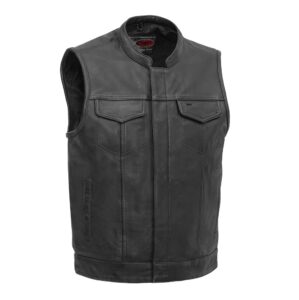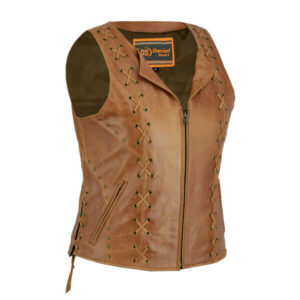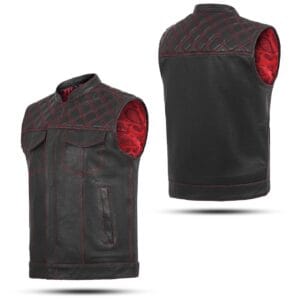So, you’ve noticed some unwelcome patches on your favorite leather vest and aren’t quite sure how to tackle them – worry not. We’re here to guide. Cleaning leather can feel like navigating a minefield, given the variety of types and finishes of leather available. But once you know the basics, it’s a straightforward process. Leather is a durable material, and with the right care, your vest can look like new again.
Firstly, it’s essential to note that leather is skin, and just like our skin, it can absorb stains and dampness. So, always make sure to check any cleaning product on a small, inconspicuous area of your vest before applying it all over – especially for colored and treated leathers.
Now, the methods of cleaning leather vests depend greatly on the type of patches we’re talking about. General dirt and grime require a different approach compared to ink stains or oil marks. Here are some steps to follow for various types of patches:
- General Dirt and Grime
- Ink Stains
- Oil or Fat Stains
Mens Black Leather SOA Anarchy Outlaw Biker Vest
Stay tuned and we’ll dive deeper into each of these procedures.
Getting to grips with the material is the first task. Leather patches can drastically vary in terms of their attachment techniques, and as such, understanding this is key for their maintenance. Do some research or try to recall if your leather vest came with a label or guide that offers cleaning tips specific to your vest’s material. Not all cleaning methods work universally for leather goods, so this step is crucial to avoid garment damage.
Approach the cleaning process with a strategy in mind. You’ll need to focus on critical trouble spots such as seams, crevices, and folds, where muck tends to build up. However, it’s equally important to tread lightly around zippers, buttons, and hardware to prevent unsightly scratches. It’s best to use a dry cloth for these areas. Aim to go over your vest in smooth, even strokes for a uniform clean when cleaning.
When cleaning areas that bend or flex frequently, a good leather conditioner can come in handy. When applied right, the conditioner helps keep the leather flexible and prevents cracks. But before you slather the solution all over your vest, do remember to test it. Pick a small, inconspicuous area, apply and let it sit to gauge its effect on your vest’s color.
Stains, unfortunately, are part and parcel of owning a leather biker vest. Quick action can go a long way in removing pesky stains caused by ink, makeup, oil, glue, or paint. For tougher stains on the lining, a specialized leather jacket cleaner can be a saving grace. These formulas typically come with a set of instructions, which you should adhere to for the best results.
Cleaning your leather vest may seem daunting at first, but with these steps, you’re well on your way to maintaining its pristine quality. Happy cleaning!
Women’s Adjustable Brown Zippered Vest with Lacing Detail
What are the common types of patches found on leather vests?
Patches on mens leather vests can be categorized based on their purpose, material, and method of attachment. One common type is the embroidered patch. These are typically sewn onto the vest and can feature intricate designs or logos. They are often used by bikers, military personnel, and other groups to represent affiliation or achievements.
Next, there are PVC patches. These are made from a type of plastic that’s flexible and durable, making them resistant to weather conditions and wear and tear. They’re usually attached using a strong adhesive or are sewn onto the vest. PVC patches can be colorful and are often used for branding or decorative purposes.
Leather patches are another type that can be found on leather vests. These are typically made from the same material as the vest itself, providing a seamless look. They can be embossed, debossed, or printed with various designs. Leather patches are often used to repair damage or to add a personalized touch to the vest.
Lastly, there are woven patches. These are similar to embroidered patches but are made with thinner threads, allowing for more detailed designs. Woven patches are typically sewn onto the vest and are popular among artists and fashion designers for their ability to replicate intricate patterns and images.
Men’s Removable Hood Naked Cowhide Vest w/ Concealed Carry
What are the potential risks or damages when removing patches on leather vests?
Removing patches from a leather vest can potentially lead to several types of damage. One of the most common risks is discoloration. The area beneath the patch may have a different color than the rest of the vest due to less exposure to sunlight and other environmental factors.
Another potential risk is the residue left by the adhesive used to attach the patch. This residue can be difficult to remove and may leave a sticky surface on the leather. If not properly cleaned, this can attract dirt and dust, leading to further damage.
Leather is a delicate material, and improper handling during patch removal can cause scratches or scuffs. These damages can be difficult to repair and may permanently alter the appearance of the vest.
Additionally, the process of removing a patch can cause the leather to stretch or warp. This is especially likely if the patch is sewn on and the stitches need to be cut or removed. The leather may not return to its original shape after the patch is removed.
Lastly, there’s a risk of puncturing or tearing the leather during the removal process. This can happen if you’re using a sharp tool to remove a sewn-on patch or if the adhesive is particularly strong. Such damage is often irreversible and can significantly degrade the overall look and quality of the vest.
Men’s Single Back Panel Vintage Brown Leather Motorcycle Vest
What are some expert tips and tricks for effectively removing patches?
Firstly, it’s important to understand that removing patches from a leather vest for women should be done with care to avoid damaging the material. One effective method is to use a hairdryer to heat up the adhesive on the patch, making it easier to peel off. Hold the hairdryer about 6 inches away from the patch and apply heat for about a minute or until the adhesive softens.
Once the patch is heated, use a pair of tweezers or a butter knife to gently lift the edge of the patch. Be careful not to scratch or puncture the leather. Slowly peel off the patch, reheating as necessary. If the patch is particularly stubborn, you may need to apply a small amount of adhesive remover or rubbing alcohol to the edges.
Once the patch is heated, use a pair of tweezers or a butter knife to gently lift the edge of the patch. Be careful not to scratch or puncture the leather. Slowly peel off the patch, reheating as necessary. If the patch is particularly stubborn, you may need to apply a small amount of adhesive remover or rubbing alcohol to the edges.
After removing the patch, there might be some residual adhesive left on the leather. This can be removed by applying a small amount of adhesive remover or rubbing alcohol to a soft cloth and gently rubbing the area. Remember to test any product on a small, hidden area first to ensure it won’t discolor or damage the leather.
Once the adhesive is removed, clean the area with a leather cleaner to remove any remaining residue. Follow the instructions on the cleaner’s label, and make sure to condition the leather afterwards to keep it soft and supple.
Lastly, if you’re not comfortable removing the patches yourself or if the vest is particularly valuable, consider taking it to a professional. They have the tools and expertise to remove patches without damaging the leather.
Men’s SOA Leather Biker Vest W/ USA Flag Lining
Getting Down To Cleaning
The process of cleaning patches on a leather vest can be a delicate task if not appropriately handled. But worry less, this guide simplifies the steps you need to follow, ensuring your vest maintains its original quality. Let’s dive into these hassle-free steps.
First, assure to focus on seams and crevices where cleaner may accumulate. This step is crucial as these areas are often ignored. So, delicately work your way into these spots with a soft, clean cloth.
Speaking of the cloth, check it frequently. If it gets too dirty, don’t continue with it, switch to a clean section. Dirty cloth can prolong the cleaning process and may also spread the dirt on other patches.
Now, when it comes to removing stains, dab them gently following a circular pattern. This method helps in lifting the stain off the patch with minimal chances of spreading it.
Once the patches are cleaned using the soft sponge, remember to wipe off the vest. Use a fresh, clean cloth that’s been slightly dampened with clean water. This step helps to remove any remaining soap residue and accumulated dirt.
In any cleaning process, it is vital to note that products can have varied effects on different materials. So, to keep your vest safe from discolorations, first test the leather cleaner on an inconspicuous area.
If you need to clean the inside of the vest too, turn it inside out. Of use will be a vacuum cleaner featuring an upholstery attachment, and you can wipe down the lining with a damp cloth alongside a mild soap solution.
In case the patches prove to be tough work, you might want to consider professional leather cleaning services. Many dry cleaners offer such services, assuring expert care and a thorough job on those stubborn stains.
Take your time during the cleaning process. Pay special attention to crevices or folds where dirt is likely to accumulate. And caution should be taken while working around zippers, buttons, and other hardware parts of the vest to prevent scratches.
Lastly, after everything is done, don’t let the vest just sit there wet. Using a dry towel, dab gently on it to absorb any remaining moisture, especially if cleaning was necessitated by food stains. This will help prevent any possible water stains and ensure a well dried-away vest.
Men’s Quilted Honeycomb Stitch Cowhide Leather Biker Vest
What are the potential risks or damages when removing patches on leather vests?
Removing patches from a leather vest can potentially lead to several types of damage. One of the most common risks is discoloration. The area beneath the patch may have a different color than the rest of the vest due to less exposure to sunlight and other environmental factors.
Another potential risk is the residue left by the adhesive used to attach the patch. This residue can be difficult to remove and may leave a sticky surface on the leather. If not properly cleaned, this can attract dirt and dust, leading to further damage.
Leather is a delicate material, and improper handling during patch removal can cause scratches or scuffs. These damages can be difficult to repair and may permanently alter the appearance of the vest.
Additionally, the process of removing a patch can cause the leather to stretch or warp. This is especially likely if the patch is sewn on and the stitches need to be cut or removed. The leather may not return to its original shape after the patch is removed.
Lastly, there’s a risk of puncturing or tearing the leather during the removal process. This can happen if you’re using a sharp tool to remove a sewn-on patch or if the adhesive is particularly strong. Such damage is often irreversible and can significantly degrade the overall look and quality of the vest.
Men’s Red Diamond Stitch Leather Motorcycle Vest
Conclusion
Taking care of your leather vest is a process. It requires close attention to detail and a commitment to preserving the item’s unique aesthetic. Cleaning patches on a leather vest adds a particular layer of complexity to the process, but armed with the right knowledge and materials, it’s a task you can manage with relative ease.
Always remember, your main aim while cleaning should be to focus on seams and crevices where cleaner may accumulate. This will serve as a guiding principle during the cleaning process. And remember, caution around zippers, buttons, and hardware is an absolute must to prevent accidental scratches or damage. Smart moves like testing the conditioner on a small, inconspicuous part of the jacket first are also recommended for best results.
If you’re considering using patches to personalize your vest, be mindful of where you purchase them from. High-quality leather patches from reliable patch makers such as ThePatchio or EverLighten can lead to long-lasting results. These patches are customizable and available in a variety of colors, adding an extra layer of personalization to a wide range of garments.
Ultimately, how you take care of your vest will be the difference between a beloved, well-worn item and a prematurely aged piece. Invest in quality patches, pay close attention to the cleaning process, and never hesitate to consult a professional if the task feels too daunting. Sometimes, paying the fee to a dry cleaners might be well worth it to ensure no unintentional damage occurs.
It’s your vest, after all, and it deserves the best possible care.







